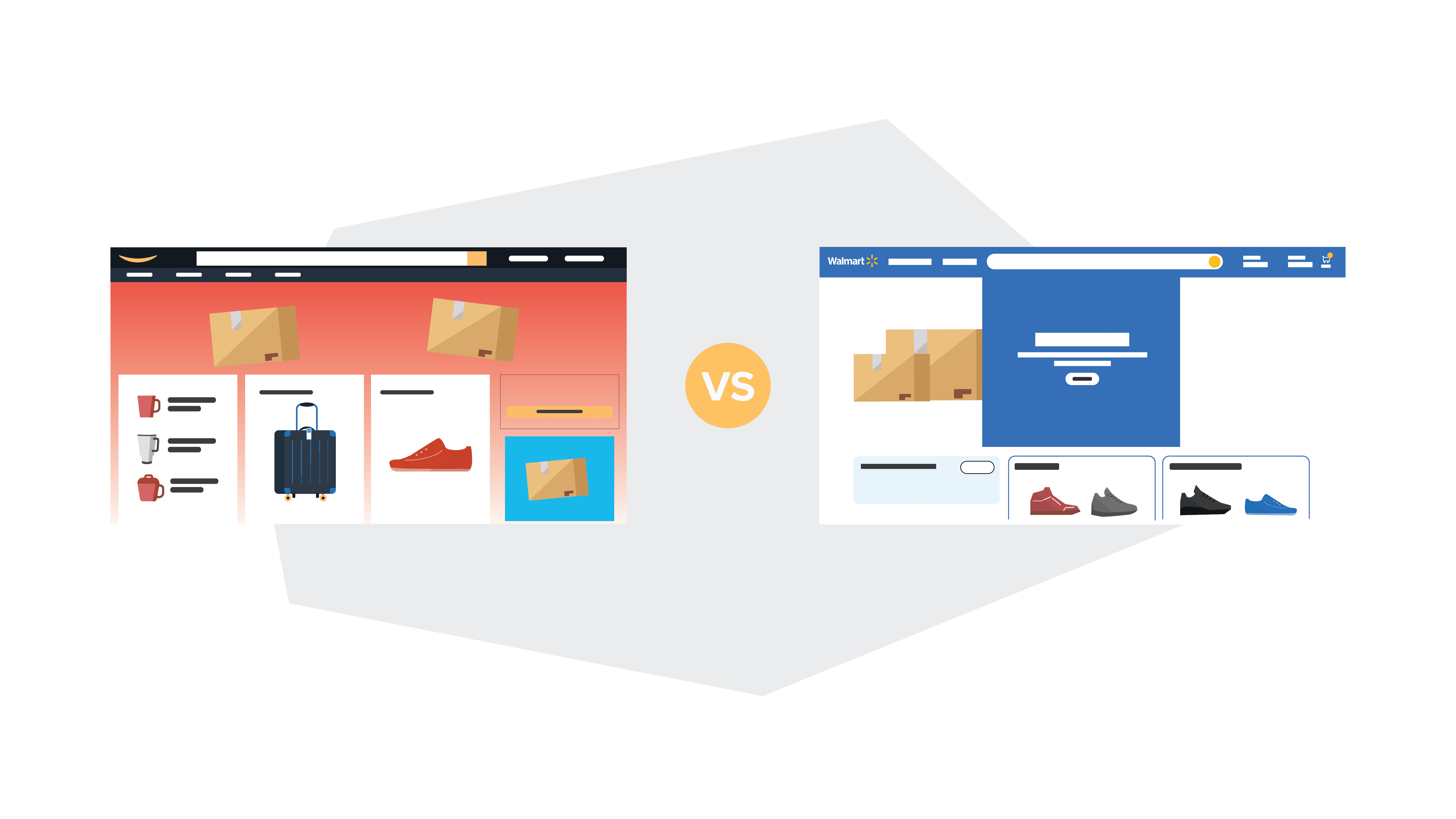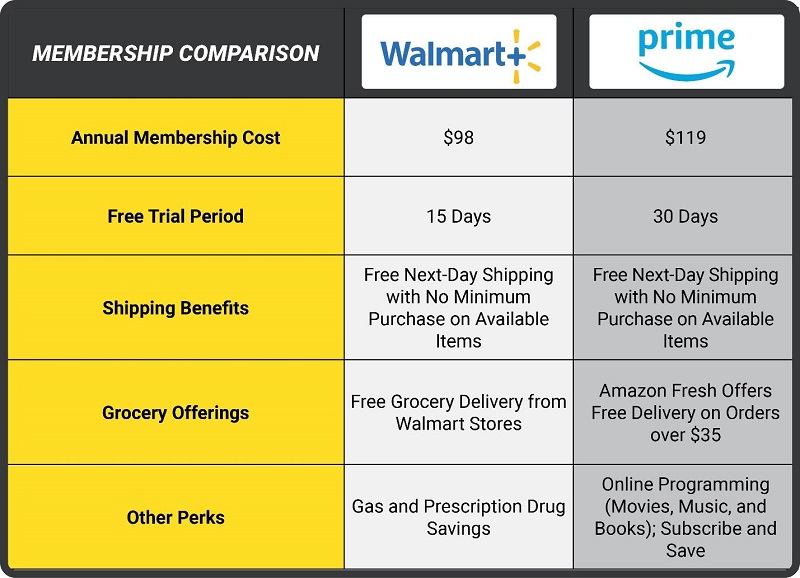
Walmart vs. Amazon: Which eCommerce Marketplace is Better For Your Brand?

This is a guest post from Channel Key, a full-service channel management marketplace consulting agency that has helped generate nearly $500M in Amazon sales for brands worldwide. Complete 360-degree services include marketplace strategies, content development, marketing and advertising, catalog management, marketplace and fulfillment setup, and ongoing consulting.
Call it the retail rivalry of the century. For 30 years, Walmart has ruled as the king of all retailers, easily outperforming its competition by offering a vast selection at low prices. Along the way came an online bookstore called Amazon. From a humble garage in Seattle, Amazon quickly grew and expanded into other market territories. It proved to be a formidable force, launching innovation after innovation.
Then, it happened: In 2019, Amazon surpassed Walmart and took the crown as the world’s largest, most valuable retailer (outside of China). In terms of gross revenue, Amazon solidified its top position this year. Forbes reported the eCommerce giant generated $610 billion in retail revenue from June 2020 to June 2021, while Walmart brought in $566 billion.
But this rivalry is far from over. The brick-and-mortar juggernaut is seeking to reclaim its title by charging onto the digital battlefield with its own platform: Walmart Marketplace.
For brands, the rivalry between Walmart and Amazon has proven beneficial, providing more opportunities to reach customers and increase sales. While eCommerce has been around for years, it’s only recently become a mainstream way of shopping. The COVID-19 pandemic turbo-charged this growth, as lockdowns, in-store capacity restrictions, and fear of contagion forced people to embrace online marketplaces like Amazon.
Today, brands know eCommerce is an essential component to their success. What remains unclear for many is which marketplace to join: Amazon, Walmart, or both?
Below, Channel Key highlights the major similarities and differences between the two platforms to help you decide which is the better eCommerce channel for your brand.
Amazon overview
As the largest and most powerful online marketplace in the U.S., Amazon is a popular platform for businesses and individual sellers.
It’s relatively simple to start selling on Amazon. The platform offers two plans: Individual and Professional. With the Individual plan, you pay Amazon a commission of $0.99 per sale. The Professional plan costs $39.99 per month no matter how many items you sell. For both, Amazon collects a referral fee from each sale as well, which is a percentage of the total transaction and varies by product category.
You also need to decide whether to sell as a first-party (1P) seller or a third-party (3P) seller. In the 1P model, you are the wholesaler and Amazon is the retailer. This follows a traditional two-tier distribution model where you negotiate pricing and terms with your Amazon buyer, sign a Vendor Agreement, and ship your product to Amazon when you receive weekly replenishment purchase orders. This business is run through the Vendor Central portal.
With 3P, you become the retailer. In this model, you set up your own Amazon storefront and sell your products directly to consumers. Sellers on Amazon have full brand authority and complete control over how they list and market their products. Unlike 1P Vendors, 3P sellers set their own pricing, determine which products to list and promote, and manage their own inventory through the Seller Central dashboard.
Amazon 3P sellers have two options for fulfilling orders: Fulfilled by Merchant (FBM) and Fulfillment by Amazon (FBA). In the FBM program, you are responsible for maintaining your own inventory and shipping products to customers. FBA sellers, on the other hand, pay Amazon to handle all receiving, packing, shipping, customer service, and returns. One of the main benefits of FBA is that your products become eligible for Amazon Prime Free Two-Day Shipping.
Walmart Marketplace overview
Walmart Marketplace is similar to Amazon in several ways. Sellers undergo an approval process, onboard their listings, choose a fulfillment option, utilize marketplace marketing and advertising programs, and get paid.
However, there are a few key differences. First, it’s challenging to qualify as a Walmart Marketplace seller. While Amazon welcomes just about anyone to open a digital storefront, Walmart is selective about the brands it allows to sell under its name; until 2016, Walmart Marketplace was an invitation-only platform.
Today, any brand can apply, but they must demonstrate a history of eCommerce experience on other platforms, reputable customer service, a compelling product assortment, and competitive pricing before receiving approval.
Walmart Marketplace offers several fulfillment options. Like Amazon’s FBM program, sellers can opt to self-fulfill orders (upon qualification) through its Seller Center platform. Walmart Marketplace FBM sellers can display the “Free Two-Day Delivery” label on their approved listings, which is a core component of the retailer’s strategy against Amazon. Thanks to the latter’s precedent, one- and two-day shipping are now factored into the customer’s purchasing decision.
Walmart seems to acknowledge the new standards Amazon set. In February 2020, the company introduced Walmart Fulfillment Services (WFS). Similar to Amazon’s FBA, WFS sellers store their inventory at Walmart fulfillment centers. When a customer places an order on Walmart.com, WFS picks, packs, and ships the item(s) on the seller’s behalf. WFS also handles all customer support and returns for these orders.
The WFS end-to-end fulfillment experience grants access to Walmart’s omni-channel capabilities, such as its Free & Easy Returns program.
Approved items wear the Free Two-Day Delivery and Fulfilled by Walmart tags for increased product visibility and higher conversion. Like FBA, the WFS cost structure includes a fixed monthly storage fee and a fulfillment price that’s based on item weight.
Walmart+ vs. Amazon Prime
Walmart and Amazon both offer subscription-based services that provide members with various benefits and perks. Launched in 2007, Amazon Prime boasts more than 200 million subscribers worldwide (102 million in the U.S. alone) and is one of the most popular and appealing features of the Amazon platform.
Walmart launched its own membership service called Walmart+ in September 2020. With 8.2 million subscribers, Walmart+ is much smaller than its Amazon counterpart. In terms of performance, it’s difficult to compare the two programs because Walmart+ has little data available. From a customer point of view, both function virtually identically and offer similar benefits.

- Source: Jungle Scout
How Walmart Marketplace stacks up against Amazon
Without a doubt, Amazon is the more powerful eCommerce platform. It has nearly 20 years of experience over its retail rival, during which time it has built a global marketplace that serves billions of customers and millions of sellers. A new report from Jungle Scout forecasts Amazon to end 2021 with over $468 billion in eCommerce revenue, while Walmart’s online revenue is expected to reach $75 billion.
That said, to underestimate Walmart’s role in eCommerce would be a mistake. For almost 50 years, Walmart has accumulated a massive customer base by offering low prices, familiar brands, and fast and easy in-store pickup and returns. This gives Walmart Marketplace the potential to become an eCommerce powerhouse – and they’re well on their way. According to the same Jungle Scout report above, Walmart’s eCommerce sales could increase 89% this year, compared to Amazon’s 16%.
The primary selling point of Walmart Marketplace is gaining access to its established network of locations and customers. In addition to 11,500 brick-and-mortar stores frequented by 265 million customers each year, more than 120 million people visit Walmart.com each month (according to their data). This is only a fraction of Amazon’s monthly search traffic, so to compensate for it, Walmart emphasizes other key distinctions to attract sellers.
Nine out of ten Americans live within 15 minutes of a Walmart store, which makes returns and customer service easy by leveraging the retail giant’s existing capabilities in its brick-and-mortar network.
Amazon pros
MASSIVE CUSTOMER BASE – Amazon dwarfs Walmart Marketplace in terms of number of customers. With an average of 2.7 billion monthly visitors worldwide (compared to Walmart Marketplace’s 100 million unique visitors per month, your brand will reach far more shoppers on Amazon.
EASY ONBOARDING – Launching your business on Amazon is much easier than on Walmart Marketplace, which requires an application and review process. Once you purchase a selling plan and set up your account, you can list your products right away.
ACCESS TO AMAZON PRIME – As an FBA seller, your products will automatically display the coveted Prime Badge. This makes your items eligible for free two-day shipping and increases their visibility for Amazon Prime Members.
TARGETED MARKETING AND ADVERTISING – Amazon’s advertising suite is much more robust than Walmart Marketplace’s platform, offering a wider selection of ad types, targeting options, and reporting tools.

- Source: Jungle Scout
Channel Key takeaways
For most businesses, whether you should sell on Amazon or Walmart Marketplace will come down to one factor: how established your company is. Just about anyone can open a Seller Central account and begin selling on Amazon.
Conversely, Walmart Marketplace requires a history of selling online via your own website or eCommerce channel. Startups and young indie brands often have no choice but to start with Amazon.
For established brands that are not on either, the question usually is not, “Should we sell on Amazon or Walmart?” But rather, “Should we sell on Amazon and Walmart?” The former is a much larger marketplace that offers access to more customers. Larger brands with strong marketing budgets will have no problem finding their customers there.
For this reason, established brands typically begin with Amazon and then consider adding Walmart Marketplace. Whether or not the latter is a good fit will depend on factors like industry and production capabilities. If you sell products in a category with high search volume and low competition, and you have the infrastructure to support both marketplaces, then Walmart Marketplace is likely a good fit for your business.
At the end of the day, there’s no magical formula to determine which marketplace is better for your brand. Both have their pros and cons.
Walmart Marketplace has been around for more than a decade, but by industry standards, it’s still in its infancy. From a seller’s point of view, this offers both advantages and disadvantages compared to Amazon.
With only around 100,000 current sellers, it can be much easier to generate traffic to your listings than on a platform with 6.4 million competitors.
On the other hand, its marketing and advertising capabilities are noticeably limited. Amazon has a much larger collection of consumer shopping data that it uses (with the help of advanced technology) to develop an increasingly expansive arsenal of tools to target customers.
Still, Walmart is no entry-level soldier in the ranks of retail. It’s the former king, a retail behemoth with six decades of momentum, and it’s determined to reclaim the throne by shifting its forces to eCommerce.
Regardless of the outcome, the true victor of this rivalry will be neither Walmart nor Amazon; it will be the brands who profit from the ongoing challenge to create the most modern and effective ways to reach their audiences, and the customers who save time and money with easier, more streamlined shopping avenues.


